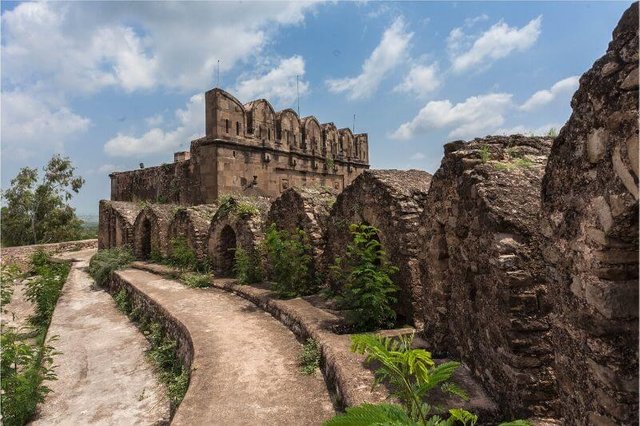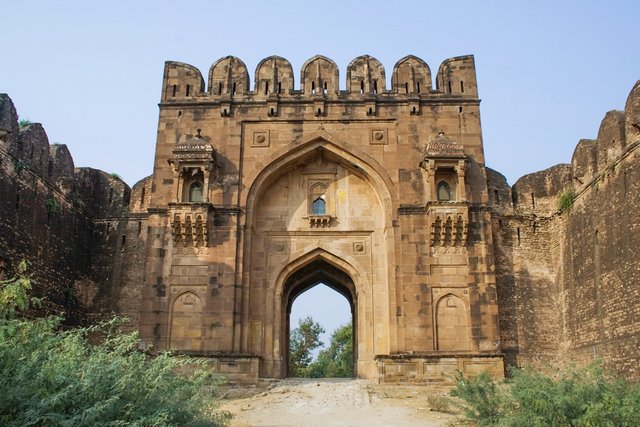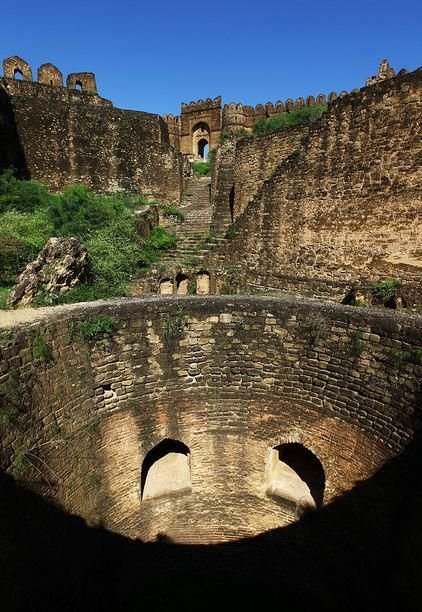Say hello to another of the most beautiful places in Pakistan – this time a 16th-century fortress that’s recognised as a UNESCO World Heritage Site. The Rohtas Fort is located near Jhelum in Punjab, which is about 4 hours from Lahore and 2 hours from Islamabad.
The fortress is one of the largest in the Subcontinent and has remained in remarkable condition despite its age. Hours can be spent roaming around the massive structure, a beautiful relic that almost seems to transport visitors back in time.
It’s easy to get lost amongst the walls and gates for an entire day. Keep in mind that the fort charges an entrance fee of 500 rupees for foreigners and 20 rupees for Pakistanis.

Rohtas Fort (1541)
Rohtas Fort is a strategic garrison situated near the modern city of Jhelum in north-east Pakistan. It was built by the Afghan king Sher Shah Suri along the so-called "old route" that leads from the north to the Punjab plains, with the intention of stopping the deposed Mughal Emperor Humayan from returning to his former kingdom. Humayan had previously been defeated by Sher Shah Suri at Chausa and fled to Iran, but he was concerned that Humayan's restoration might be possible if he managed to return to the Punjab. Sher Shah Suri's second concern was to punish and defeat the Gakkhar tribes who held control of the valley and were traditional allies of the Mughals.

The fort's name derives from the stronghold at Rotasgarh in Shahabad district which Sher Shah Suri captured from a Hindu prince in 1539. Work on the fort began in 1541 under the supervision of his revenue minister, Todar Mal Khatri. However, the local population of Gakkars were unwilling to work, even as day laborers, and construction quickly stalled. Todar Mal Khatri wrote to Sher Shah Suri of these difficulties and the king responded that his government would bear any expenses for the cost of construction. With this inducement, Todar Mal Khatri was able to raise wages which induced a number of Gakkars to break rank and join in the construction effort.

Although the daily pay was reduced several times during the course of construction, it was still sufficient to allow Sher Shah Suri's dream of a fort to come to fruition.
The layout of the fort is roughly triangular and comprises four kilometers of walls, 68 bastions, and about a dozen major gates. The northwest corner of the fort is divided from the rest of the fort by a 530 meter long wall which establishes a separate citadel area that was more heavily fortfied. It also contains several of the remaining architectural relics, including the Shahi Mosque and the Haveli Man Singh (built on the highest spot within the fort). It is also equipped with step wells (baoli) although these are also found in the greater area of the fort to the southeast.
The fort's walls vary in thickness and reach a maximum depth of 12.5 meters near the Mori gate on the north perimeter, whereas their height varies from 10 to 18.3 meters. The primary building material was sandstone course rubble masonry mortared with lime mixed with granular brick powder. The gates are constructed of much stronger ashlar masonry. In many places the walls contain vaulted chambers which were used for storage and other equipment needed by the roughly 30,000 soldiers who could be stationed there.
Sher Shah Suri died before the fort was fully completed and the chief aim of the fort became redundant when Humayan returned to rule the Punjab. In a larger irony, the fort then became the capital of the Gakkars--the very people Sher Shah Suri had aimed to subdue. Even though the fort was under Mughal control from that point onward it was not very popular with the Emperors because it lacked gardens and other grand architecture to which they had become accustomed.

It was no longer even a military necessity as the Gakkars remained steadfast Mughal allies. Remilitarization of the fort only began in the waning years of the Mughals when Rajit Singh, the Sikh emperor, took control of the Punjab. An emboldened general Gurmukh Singh Lamba captured the fort from the Ghakhar chief Nur Khan in 1825, and it was later handed to Sardar Mohar Singh and was subsequently leased to others. The final military use of the fort took place when Raja Fazal Din Khan joined Sher Singh in rebellion, though the fort did not see any action.
The fort was added to the list of World Heritage Sites by UNESCO in 1997.
Plagiarized Content
@yasirali281, first of all, you haven't made your achievement 1 until now to get verified.
Secondly, you are posting plagiarized content continuously. the content is from the internet.
The sources are
@endingplagiarism
@jawad101
Downvoting a post can decrease pending rewards and make it less visible. Common reasons:
Submit
This content appears to be plagiarised as indicated by @aniqamashkoor.
If you have not already done so, you should head to the newcomers community and complete the newcomer achievement programme. Not only will you earn money through upvotes, you will learn about content etiquette;
You are currently in Stage 1 of our 4 Stage Process:
👉 Stage 1 - 1st Warning - Pointing offenders towards Achievement 3 and highlighting this process. All plagiarised posts currently pending rewards will be flagged and downvoted to $0 rewards.
Stage 2 - A Final Warning - Another request to stop and that plagiarism will not be tolerated. Downvotes amounting to 20% of total pending rewards according to steemworld.
Stage 3 - A stronger message - Downvotes amounting to 50% of pending rewards.
Stage 4 - The strongest message possible - Downvotes amounting to 100% of pending rewards.
Plagiarists will bypass stage 1 if translated from another language.
Notification to community administrators and moderators:
@toufiq777 ADMIN Curator+CR Bangladesh
@nahidhasan23 MOD Verified+Delegation [2000sp]
@sohanurrahman MOD Verified+Delegator [650SP]
@steem-bangladesh MOD Community Blog Account
Downvoting a post can decrease pending rewards and make it less visible. Common reasons:
Submit